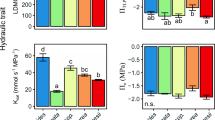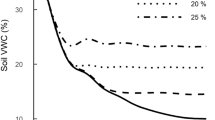Abstract
Interactions between changing precipitation regimes and other aspects of global change are likely to affect natural and managed terrestrial ecosystems. Relatively little research has focused on understanding how ecosystems respond to changes in precipitation regimes, which are expected to have significant impacts for ecosystem functioning, species distribution, species richness and biodiversity especially in arid ecosystems. There is a need for integrated studies to understand the functional ecology of different species in order to predict their success under changing environmental conditions. One example for such an integrated assessment is a study by Xu and Li (this issue) on water-use strategies of desert shrubs. By combining investigations of morphological traits, such as root architecture, with ecophysiological measurements Xu and Li were able to elucidate the differing adaptive strategies of three desert shrubs in their arid environment. The plant physiological response of the plants was closely related to their water-use strategy and was coupled with the functional type of the root system. Integrated research such as this will lead to a more complete understanding of the water and carbon economy of plant species and ecosystems and will allow a more accurate prediction of plant responses to changing environmental conditions.
Similar content being viewed by others
References
Chesson P, Gebauer RLE, Schwinning S, Huntly N, Wiegand K, Ernest MSK, Sher A, Novoplansky A, Weltzin JF (2004) Resource pulses, species interactions, and diversity maintenance in arid and semi-arid environments. Oecologia 141:236–253
FAO (1993) Sustainable development of drylands and combating desertification. Food and Agriculture Organization of the United Nations, Rome
Goldberg D, Novoplansky A (1997) On the relative importance of competition in unproductive environments. J Ecol 85:409–418
Houghton JT, Ding Y, Griggs DJ, Noguer M, van der Linden PJ, Dai X, Maskell K, Johnson CA (2001) Climate change 2001: the scientific basis. Cambridge University Press, Cambridge, 881 pp
Kahmen A, Perner J, Buchmann N (2005) Diversity-dependent productivity in semi-natural grasslands following climate perturbations. Funct Ecol 19:594–601
Noy-Meir I (1974) Desert ecosystems: higher trophic levels. Annu Rev Ecol Syst 5:195–214
Trubat R, Cortina J, Vilagrosa A (2006) Plant morphology and root hydraulics are altered by nutrient deficiency in Pistacia lenticus (L.). Trees 20:334–339
Weltzin JF, Loik ME, Schwinning S, Williams DG, Fay PA, Haddad BM, Harte J, Huxman TE, Knapp AK, Lin G, Pockman WT, Shaw MR, Snall EE, Smith MD, Smith SD, Tissue DT, Zak JC (2003) Assessing the response of terrestrial ecosystems to potential changes in precipitation. Bioscience 53:941–952
Westoby M, Wright IJ (2006) Land-plant ecology on the basis of functional traits. Trends Ecol Evol 21:261–268
Xu H, Li Y (2006) Water use strategy of three central Asian desert shrubs and their responses to rain pulse events. Plant Soil (this issue)
Zeng F, Bleby TM, Landman PA, Adams MA, Arndt SK (2005) Water and nutrient dynamics in surface roots and soils are not modified by short-term flooding of phreatophytic plants in a hyperarid desert. Plant Soil 279:129–139
Acknowledgements
The authors work is supported by the Department of Sustainability and Environment of Victoria and the Australian Research Council.
Author information
Authors and Affiliations
Corresponding author
Rights and permissions
About this article
Cite this article
Arndt, S.K. Integrated research of plant functional traits is important for the understanding of ecosystem processes. Plant Soil 285, 1–3 (2006). https://doi.org/10.1007/s11104-006-9097-0
Received:
Accepted:
Published:
Issue Date:
DOI: https://doi.org/10.1007/s11104-006-9097-0




